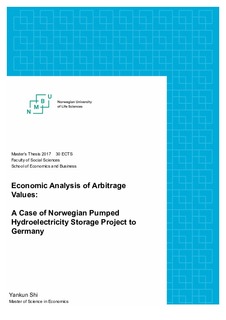| dc.description.abstract | In the face of the rapid growth of electricity which generally comes from renewable sources, intermittent solar and wind power are hindering the sustainability of electricity production. Especially in the absence of sunny and windy weather conditions, storing economic surplus electricity by the PHS method with high energy efficiency, which is a cost-effective solution to improve the security of electricity supply.
In this study, we focus on the evaluation of the potential arbitrage values of the project of Norwegian pumped hydroelectricity storage when connecting with German electricity markets. The time series is within 24 hours of a day or 168 hours of a week in the entire period between 2012 and 2016. The spot price data is collected from the OSL1 and EEX, and here we observe the price volatility between the peak and off-peak prices by the sever graphs of the daily and weekly patterns made by STATA. We select the electricity price theory in the dayahead electricity spot markets and the supply-demand model and investigate how price volatility between the peak and off-peak electricity prices affects hourly arbitrage strategies when the Norwegian pumped hydroelectricity storage (PHS) project is expanded to Germany. We employ the daily and weekly patterns of hourly electricity spot prices within 24 hours of a day and 168 hours of a week for the entire period between 2012 and 2016. Each pattern is tested by using the time series data on the historical hourly electricity spot prices on the OSL from the Nord Pool and the EEX. The levels of arbitrage values depend on the estimated daily or weekly patterns of the average hourly electricity spot prices of the OSL and the EEX.
Arbitrage policies by the daily and weekly patterns are estimated through the costefficient cycle of pumped hydroelectricity production in the Norwegian PHS, namely (use the cheap electricity from the grids to pump water back into the upper reservoir when electricity prices are low within the off-peak hours of the day, starting at midnight to the next early morning and then pump the water back into the low-level reservoir and convert back into hydroelectricity to be sold when the high prices at the peak hours of the day). Finally, we find that the daily pattern of electricity prices between the buying hours (23-6) and the selling hours (7-22) of the day is statistically significant and more profitable than weekly pattern between the weekend and the five workdays within 168 hours of the week, to achieve optimal arbitrage values in the German electricity market when the Norwegian PHS project connecting with Germany in the short term. Further, we find that Norway has slightly decreased the arbitrage values in the German electricity market when the increasing share of electricity production from solar and wind power. | nb_NO |

